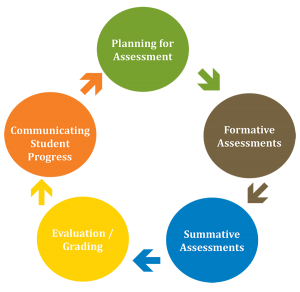
Principle #4
Formative assessment (as learning) involves students in setting personal goals for learning and monitoring their progress through self-assessment practices.
“It’s no secret that students learn best when they are actively and intentionally engaged in their own learning. But classrooms full of actively engaged students don’t just happen. They are created when teachers intentionally work to develop self-regulated learners who set their own goals, select effective strategies to reach those goals, and monitor and adjust what they do depending on the demands of the task and their own strengths and needs.”
—Brookhart and Moss, 2009
Assessment as learning is a process of developing and supporting students thinking about themselves as learners, and assisting them in making the critical connection between assessments and their learning. When students are active, engaged critical self assessors, they make sense of information, relate it to prior their knowledge, and use it to shape and direct their new learning. When students monitor their own learning and use teacher feedback to make adjustments, adaptations, and even major changes in what they understand, they are engaging in a metacognitive process. Teachers foster student self-assessment and self-efficacy by helping students develop, practice, and become comfortable with reflection, as well as develop their ability to critically analyze their own learning. (Western and Northern Canadian Protocol for Collaboration in Education (WNCP), 2006.
Opportunities for self-assessment and goal setting should be provided throughout the instructional cycle. As students become more skilled at reflecting and adjusting what they are doing, the quality of their work improves (Cooper, 2006). Students need to be taught explicitly how to incorporate this into their work. When students are involved in a continual process of reflecting on their progress, setting goals for improvement and carrying out the feedback, they learn more effectively, become better critical thinkers and reduce achievement gaps. (Black & Wiliam, 1998; Chappuis & Stiggins, 2002).
Students capable of self-assessment are aware of their current level of understanding in a learning area and understand their learning path. They are aware of the tools and resources needed to guide their learning and are able to seek feedback and recognize their errors. Moss and Brookhart (2009) propose that student goal setting should be based on three key questions:
- Where am I going?
- Where am I now?
- What strategy or strategies will help me get to where I need to go?
ASSESSMENT CYCLE

TRY THIS
Click here for ideas to try in the classroom
1) Model self-assessment.
2) Teach goal setting explicitly:
- Consider using a framework such as SMART goals.
3) Differentiate for self-assessment:
- Use a variety of Core Competency self-assessment templates from the Curriculum Hub at nvsd44curriculumhub.ca.
4) Provide frequent opportunities for self-assessment:
- Model giving specific, descriptive feedback.
- Allow students opportunities to reflect on what they learned and apply it.
5) Run a project tuning session:
6) Scaffold assessment practices and goal setting.
7) Allow time and opportunities for development between stages of assessment.
8) Frequently set short and long-term goals with students.
9) Revisit goals frequently:
- Check progress
- Adjust plans if needed
10) Use templates for goal setting:
- Use resources on nvsd44curriculumhub.ca.
WATCH THIS
Click here to watch related video content
Dylan Wiliam: Formative Assessment
Watch as Dylan Wiliam reviews the nature of formative assessment and how teachers can use it to gain better insights into student learning and achievement.
Carol Dweck, “Developing a Growth Mindset”
Should you tell your kids they are smart or talented? Professor Carol Dweck answers this question and more, as she talks about her groundbreaking work on developing mindsets. She emphasizes the power of “yet” in helping students succeed in and out of the classroom.
Smart Goals: How to Make Your Goals Achievable
Many people spend their lives drifting from one job to another, or rushing around trying to get more done while actually accomplishing very little. Setting SMART goals means you can clarify your ideas, focus your efforts, use your time and resources productively, and increase your chances of achieving what you want in life. Learn more.
READ THIS
Click here for additional reading suggestions
To learn more, check out these texts:
- Moss, C. & Brookhart, S. (2009). Advancing Formative Assessment in every classroom: A guide for instructional leaders. Alexandria, Virginia. Association for Supervision and Curriculum Development.
- Ontario Ministry of Education. The Literacy and Numeracy Secretariat Capacity Building Series. (2007). Retrieved at http://www.edu.gov.on.ca/eng/literacynumeracy/inspire/research/studentselfassessment.pdf.
- Ontario Ministry of Education. Growing Success. (2010). Retrieved at http://www.edu.gov.on.ca/eng/policyfunding/growSuccess.pdf.
- Shepard, Lorrie A. “The Role of Assessment in a Learning Culture.” Educational Researcher 29, no. 7 (Oct 2000): 4:14.
- Western and Northern Canadian Protocol for Collaboration in Education. (2006). Rethinking Classroom Assessment with Purpose in Mind. Retrieved at: https://www.wncp.ca/media/40539/rethink.pdf.
- Wiliam, D. (2011). Embedded Formative Assessment. Bloomington, Indiana. Solution Tree Press.
- Wiliam, D. (2006). Assessment: Learning communities can use it to engineer a bridge connecting teaching and learning. National Staff Development Council, 27(1), 16-20.
